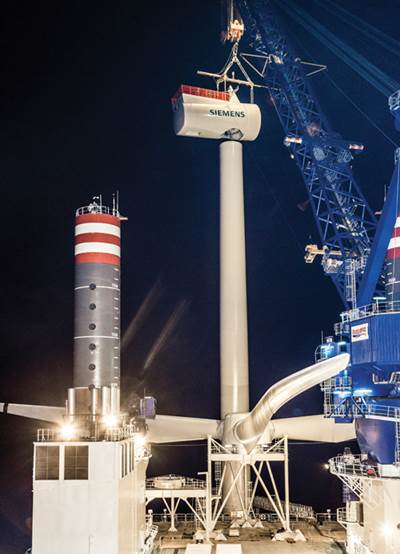Redefining the root
As part of a radical redesign effort that has produced a segmented blade, Blade Dynamics Ltd. (Cowes, Isle of Wight, U.K.) developed a thinner, less weighty root than that seen in conventional blades.
As wind turbine blades lengthen, the strength-to-weight ratio becomes a mathematically more difficult equation because blade mass increases at a faster rate than energy capture. The critical role played by the blade root, the blade’s point of connection to the rotor and a focal point of operational stress, makes it a particularly challenging target for weight reduction. Nevertheless, blade designers are increasingly taking aim, and the results are promising.
LM Wind Power (Kolding, Denmark), for example, says its all-glass fiber-reinforced 73.5m/240-ft long blade, currently the world’s longest installed blade, features a GloBlade root with the same bolt circle diameter used on smaller LM blades. At 3.2m/10.4 ft, the root’s optimized design supports the blade’s greater mass.
Although details of LM’s optimized root aren’t available, much more is known about the unconventional root design for the longest wind turbine blade produced to date. its builder, SSP Technology A/S (Kirkeby, Denmark), used a root design for the 83.5m/271-ft structure that is now available for sale to other blade producers as a kit or a standalone part.
It is made with glass/epoxy prepregs that are precut on computerized cutting machines. Although a conventional root features a very thick fiberglass laminate that must be drilled, postcure, for insertion of T-bolts, SSP’s relatively thin root section is formed in two female mold halves. Steel inserts or bushings, approximately 460 mm/18 inches long and located about 25 mm/1 inch apart, are encapsulated within the oven-cured prepreg layup.
Says SSP’s CEO, Søren Brouer, “The prepreg construction holds the bolt inserts so tightly that we have not been able to pull any out during testing.” SSP says the minimal distance between the comolded bolts optimizes its load-bearing capacity. Further, Brouer points out that when an SSP blade is attached to a rotor hub during wind farm installation, there is no need for follow-up retightening of the bolts during the first maintenance round. This eliminates a costly and laborious step that is required for traditional, bonded T-bolts.
As part of a radical redesign effort that has produced a segmented blade, Blade Dynamics Ltd. (Cowes, Isle of Wight, U.K.) developed a thinner, less weighty root than that seen in conventional blades. The solution is a composite “carrot”-shaped root insert that tapers to a thin wedge. To create the inserts, composite material is wrapped around metal bushings that have spiral threading on the inside and outside. Closely spaced inserts are then embedded within a thin “corrugated” root laminate, explains Blade Dynamics’ senior technical manager, David Cripps (see image). “The whole arrangement is much lighter than conventional roots where T-bolts are used, which require very thick laminates to provide the necessary bearing area for the ‘nut’ of the T-bolt and to spread the arising stress concentrations into the blade root and spar arrangement,” Cripps explains. The company says the greater strength-to-weight and fatigue resistance of its root contributes to the overall lower weight of its blades. That, in turn, allows for the use of lighter components throughout the turbine and rotor, including drivetrain components, and reduces overall project costs.
Related Content
JEC World 2022, Part 3: Emphasizing emerging markets, thermoplastics and carbon fiber
CW editor-in-chief Jeff Sloan identifies companies exhibiting at JEC World 2022 that are advancing both materials and technologies for the growing AAM, hydrogen, automotive and sustainability markets.
Read MoreDrag-based wind turbine design for higher energy capture
Claiming significantly higher power generation capacity than traditional blades, Xenecore aims to scale up its current monocoque, fan-shaped wind blades, made via compression molded carbon fiber/epoxy with I-beam ribs and microsphere structural foam.
Read MoreRecycling end-of-life composite parts: New methods, markets
From infrastructure solutions to consumer products, Polish recycler Anmet and Netherlands-based researchers are developing new methods for repurposing wind turbine blades and other composite parts.
Read MoreMaterials & Processes: Fabrication methods
There are numerous methods for fabricating composite components. Selection of a method for a particular part, therefore, will depend on the materials, the part design and end-use or application. Here's a guide to selection.
Read MoreRead Next
Fair winds for offshore wind farms
Innovations in blades, turbines and foundations are helping spur growth in a very big way.
Read MoreComposites end markets: Energy (2024)
Composites are used widely in oil/gas, wind and other renewable energy applications. Despite market challenges, growth potential and innovation for composites continue.
Read MoreFrom the CW Archives: The tale of the thermoplastic cryotank
In 2006, guest columnist Bob Hartunian related the story of his efforts two decades prior, while at McDonnell Douglas, to develop a thermoplastic composite crytank for hydrogen storage. He learned a lot of lessons.
Read More









.jpg;maxWidth=300;quality=90)
















